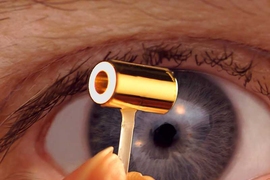Senior research scientist Chikang Li wants to experiment with the stars. Intrigued by a curious “kink” phenomenon observed in the Crab Nebula, an interstellar cloud of gas and dust that formed in the wake of a supernova explosion, he has been looking for answers. Images from the Chandra X-ray observatory show that a jet of plasma pouring straight out from the neutron star at the center of the nebula appears to change direction every few years, without changing its structure. Why? Scientists have hypothesized that magnetic fields with the right properties could explain this behavior, but Li wanted proof.
“How do you design an experiment on Earth to explain mysteries that are happening 6,500 light years away, and stretching over 13 light years of space?” he asks. “Traditional astrophysics is based on observation. Typically after you make an observation, you build a theoretical model, you do some numerical simulations. But that’s it. How can you go there and measure anything? How can you do an experiment to test this model?”
Li has been part of MIT’s Plasma Science and Fusion Center (PSFC) since becoming a graduate student in 1987. As a co-founder and associate head of the PSFC’s High-Energy-Density Physics (HEDP) Division, Li has collaborated regularly with the National Ignition Facility and the University of Rochester’s Laboratory for Laser Energetics on inertial confinement fusion and laboratory-astrophysical experiments. He decided to see if he could also use the lab's OMEGA laser to mimic the conditions in the Crab Nebula, and prove the hypothesis that magnetic fields were responsible for the “kink in the crab”.
Instead of training OMEGA’s multiple laser beams on a single pellet of hydrogen fuel, as he would for a fusion experiment, Li bounced lasers off two 3 x 3 mm foils hinged together at a 60-degree angle. Using two laser beams to heat each side, he generated plasma bubbles, or plumes. Li knew that because they are very dense and hot, these plumes would immediately expand, colliding in the middle plane between the two foils to form a jet.
Li notes that even though laboratory-generated jets and astrophysical jets have very different size scales, the fundamental physics can be the same because critical dimensionless parameters are similar. As a result, they share enough physical properties to allow Li to scale his laboratory experiments, as one would do from a wind tunnel to an airplane, to conditions in the crab nebula.
While the kink in the nebula jet occurs over a period of a few years, the laboratory experiment creates a jet in one nanosecond (billionth of a second), which then propagates for five to six nanoseconds. Li laughs as he considers the speed of the experiments: “You have to generate that, diagnose that, characterize that, quantify that in this period of time!”
To measure the magnetic fields generated by the experiment, Li used a monoenergetic proton radiography (MPR) diagnostic invented by his division in 2005, allowing him, through the deflection of the protons, to make a radiograph of the fields. With the quantitative measurements in hand, he has been able to prove that the nebula jet behavior is governed by weak magnetic fields along the jet, which keep its structure largely straight, and other magnetic fields circling around the jet, which create the instability responsible for the directional change. The results were recently published in Nature Communications.
HEDP division head Richard Petrasso noted the importance of Li’s work: “Through his understanding of instabilities and his development of the MPR diagnostic to map transient magnetic fields in the laboratory, Chikang has been able to explore and explicate, for the first time, such puzzling phenomena as the jetting in the Crab Nebula.”
Li, and graduate students working under his supervision, are now in the process of extending this methodology to a range of other astrophysical phenomena, such as the turbulent generation and amplification of magnetic fields, and the observation of collisionless shocks and their associated magnetic fields.
With the ability to create measurable astrophysical conditions on earth using the National Ignition Facility and OMEGA lasers, the sky’s the limit.








